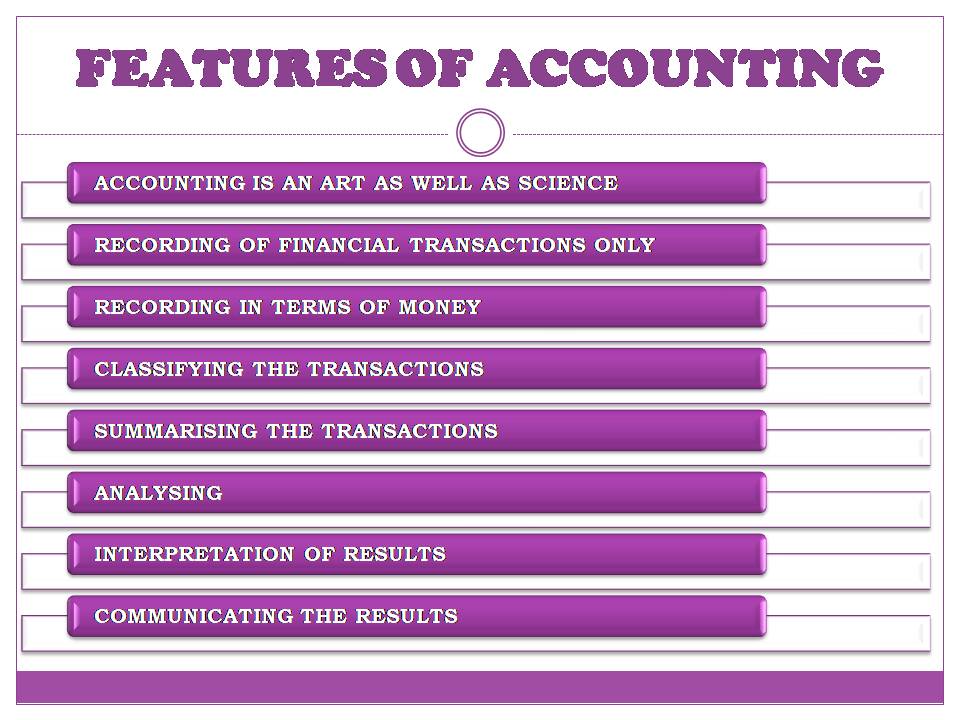FEATURES OF ACCOUNTING
Accounting refers to the mechanism of maintaining and keeping the records of the transactions and events and also its analysis and interpretation. It also includes the preparation of final accounts such as Trading and Profit and Loss Account and Balance Sheet at the end of the financial year. It is associated with communicating the interpreted results of the financial information to its users. The characteristics or attributes or features of Accounting are as follows:

ACCOUNTING IS AN ART AS WELL AS SCIENCE:
Accounting is an Art of recording, classifying, summarizing, analyzing and interpreting the accounting records with a view to ascertain the net profit/ loss and financial position of the business.
Accounting as a Science is an organized body of knowledge that contains some underlying principles and rules that are followed while maintaining accounts. However, Accounting is not a pure science as it does not establish cause and effect relationship.
RECORDING OF FINANCIAL TRANSACTIONS ONLY:
Accounting records only those transactions and events that are expressed in monetary terms or in quantitative form. For instance, the transactions like sale of goods for ₹5,000 will be recorded in the books of accounts.
However, there are so many events which are very important for business but cannot be recorded in the books of accounts because such events cannot be expressed in quantitative or monetary form. For example: Loyalty of Employees, Resignation by an able and experienced manager, Strike by employees, Quarrel between employee and employer etc. but these events have a large impact and direct bearing on the business of the firm.
RECORDING IN TERMS OF MONEY:
The accounting records only those transactions which can be expressed in terms of money only. It implies that a business man will not record the purchase of 5 chairs and 5 tables, he will record the purchase of 5 chairs costing ₹2,500 and 5 tables costing ₹5,000.
Also the recording is done in the book of the journal which is the primary book of recording the transactions in the chronological order.
In small business houses, the recording of transactions is generally done in the book of Journal whereas in big business houses the recording of transactions is done in the subsidiary books:
- Cash Book
- Purchase Book
- Sales Book
- Purchase Return Book
- Sale Return Book
- Bills Receivable Book
- Bills Payable Book
- Journal Proper
The number of subsidiary books to be maintained depends upon the nature and size and needs or requirements of the business.
CLASSIFYING THE TRANSACTIONS:
One of the Features of Accounting is that it classifies all the transactions recorded in the book of the Journal. Classification refers to grouping the transactions of same nature at one place, in a separate account. Classification of transactions is done in the books of ‘Ledger’. All the accounts related to creditors, debtors, capital, assets, liabilities, incomes and expenses are separately opened in the Ledger Book. Example: Wages Account, Ram Account, Advertisement Account, Cash Account, Bank Overdraft Account etc.
SUMMARISING THE TRANSACTIONS:
Summarizing is the art of presenting the classified data in a manner which is understandable and useful to management and other users of such data. It involves:
- Balancing of Ledger Accounts
- Preparation of Trial Balance
- Preparation of Trading and Profit & Loss A/c
- Preparation of Balance Sheet
Trial Balance is a summary of all the ledger accounts and is maintained to check the arithmetical accuracy of accounts. Trading Account is prepared to find out the Gross Profit or Gross Loss while Profit & Loss Account helps in knowing Net Profit or Net Loss. Balance Sheet prepared at the end of accounting year helps in knowing the financial position of the concern. It shows the Profitability, Solvency as well as Liquidity position of the business.
ANALYSING:
Analyzing is concerned with the establishment of relationship between the various items or groups of items taken from Income Statement or Balance Sheet or both. Purpose of analysis is to identify he financial strengths and weaknesses of the enterprise. It provides the base for analysis.
INTERPRETATION OF RESULTS:
Another feature of accounting is interpretation of results. Interpretation of results is concerned with explaining the meaning and significance of the relationship so established by the analysis. Interpretation of results requires high degree of knowledge and skills. The accountant should answer:
- What has happened?
- Why is happened?
- What is likely to happen under specified conditions?
COMMUNICATING THE RESULTS:
Accounting is so featured that it will provide the analyzed and interpreted results to its users such as Management, Employees, Creditors, Research Scholars, Debtors, Financial Institutions, Competitors, Bankers, Income Tax Authorities etc. The results are communicated by preparing final accounts, ratios, graphs, diagrams, charts, fund flow statement, cash flow statement etc.